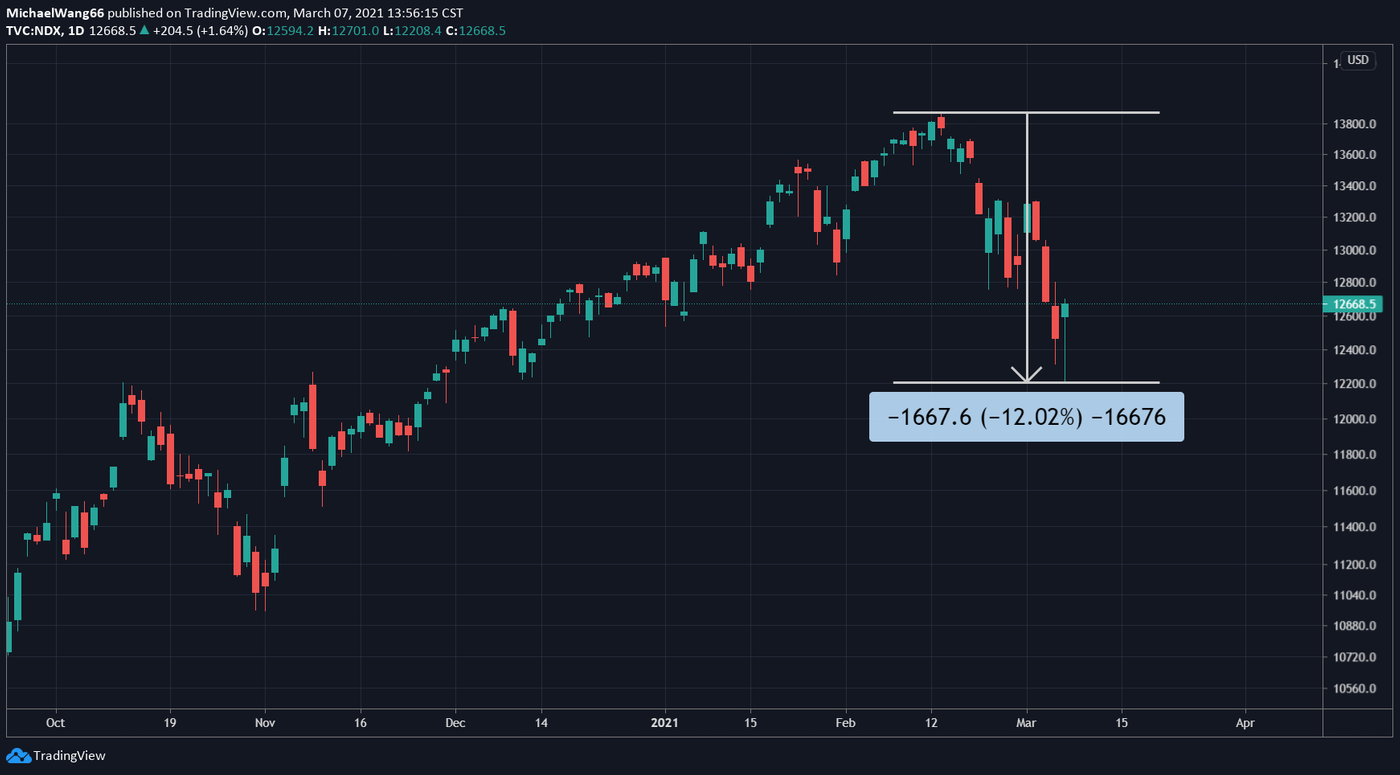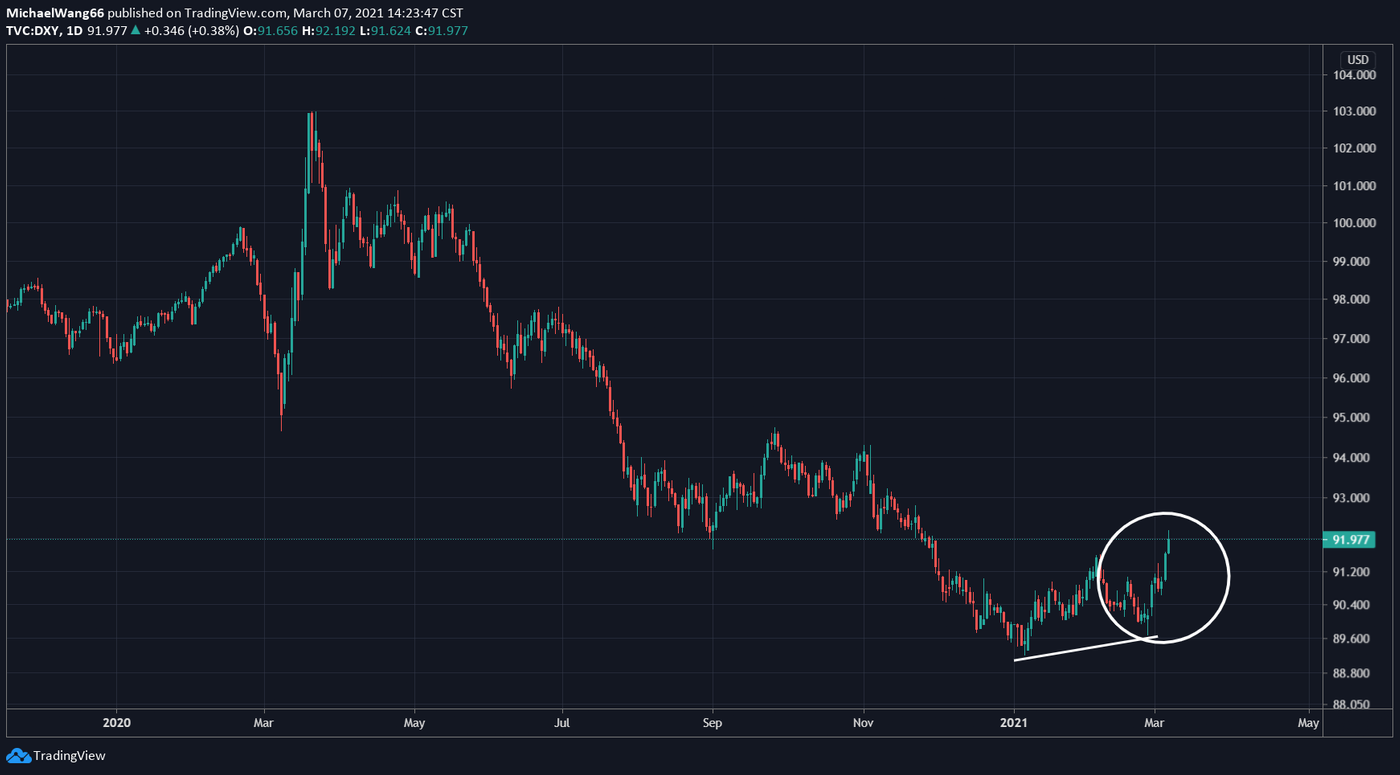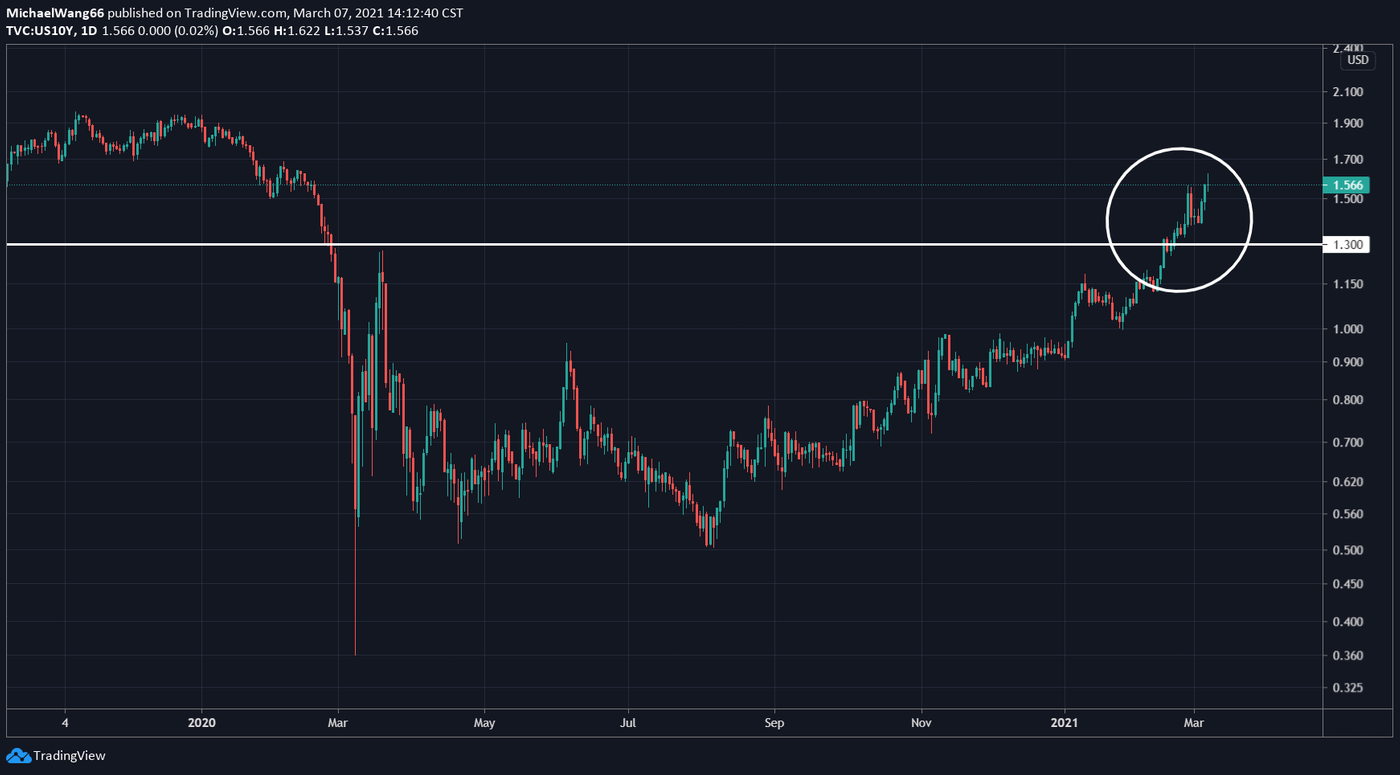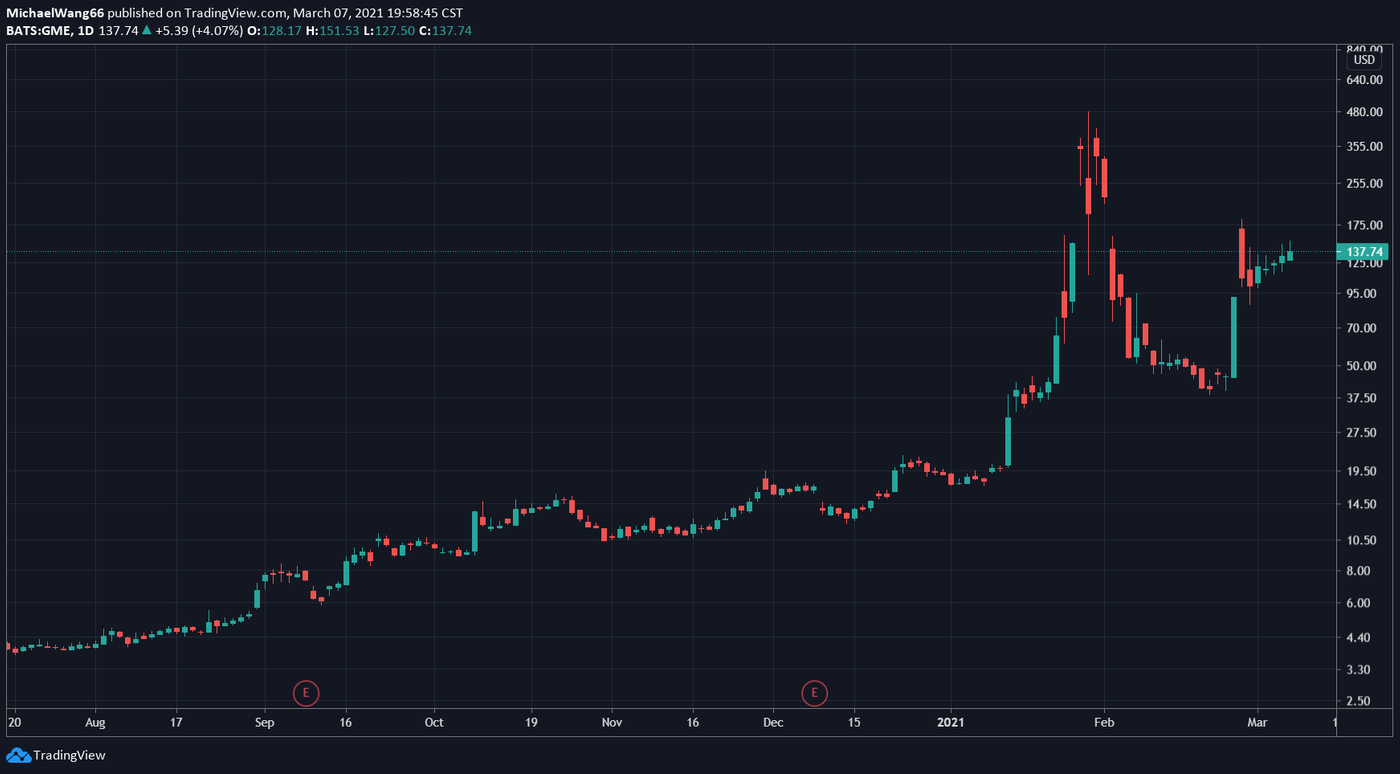
軟體工程師,加密貨幣基金管理者,遊戲玩家。 近期興趣是 Elden Ring! https://twitter.com/michael_icwang https://medium.com/@michael_icwang
Crypto Investment Diary 3/7 - How to Understand the Double Killing of Equity and Debt
The investment market has changed a little in the past two weeks: the stock market and the bond market fell together. This phenomenon is uncommon and seems to reveal an unusual taste. Out of curiosity, I did a little research and recorded it here.
Disclaimer: I am not a financial major, what I write here is my personal opinion, and it is by no means an investment suggestion for you. Please invest at your own risk.
National debt basics
Most investors are relatively unfamiliar with bonds (myself included), so it takes a little bit of a concept to build on before understanding the rest.
A bond is an IOU/IOU that says how much A is borrowing from B, what interest rate it is, and how long it will take to pay it back.
National debt refers to the IOU issued by the state to borrow money from the general public.
U.S. bonds refer to bonds issued by the U.S. federal government. Since the end of World War II, U.S. bonds have been the most trusted assets in the world, and even other countries will buy U.S. bonds. (This is an important one, and part of the recent changes).
When treasury bonds are issued, the government sells them and other buyers buy them, forming a primary market . Afterwards, the person who gets the bond (that is, the person who lends the money to the government) can also sell it to other people again, forming a secondary market . This is nothing special, just like what you and I buy and sell in the stock market, almost all of them are not first-hand issued by the company, but resold and sold again, that is, the secondary market.
There is an important difference between the secondary market of bonds and stocks. In addition to the price change of the bond itself, the "interest rate" of the bond will also change with the price:
- When the market is rushing for government bonds, the price will rise (the law of supply and demand). If the interest rate promised by the country at the beginning remains unchanged, the bond yield rate will be adjusted. Because interest = principal x interest rate, if the principal (market price) becomes higher, the interest rate will be lowered to get the same interest. therefore:
Market wants → bond prices rise → yields fall - on the contrary:
Markets don't → bond prices fall → yields rise
hedging risk
The world's assets, in the final analysis, can be classified into two categories:
- Risk assets: Profits and risks are associated with each other. As the so-called "don't get into a tiger's den, you can't get a tiger's child. Therefore, assets with high uncertainty and high volatility are considered risky assets." Generally, the stock market and various financial products derived from it are regarded as risk assets.
- Safe-haven assets: Assets with relatively certain profits and less volatility can be regarded as safe-haven assets. Gold and government bonds are generally regarded as safe-haven assets. Governments all over the world have gold. After the U.S. dollar broke away from the gold standard in 1971, U.S. government bonds were the most trusted assets in all countries. After companies and countries made money, they would buy a lot of U.S. bonds. .
It should be noted that whether an asset is a risk or a safe-haven asset, there are no fixed rules, everything is people's cognition at work.
It is conceivable that if you control enough money, you can't just put it on the side of risky assets (money has its own feet, and will lose some of it and run to safety), or only put it on the side of safe-haven assets (people will dislike you Too conservative, take a part of your own to risk assets). So you have to figure out the ratio of these two asset allocations, and change the ratio between the two as the market sentiment changes.
This concept of putting some money in risky assets to take risks and the other part in safe-haven assets is called hedging. Usually, when risk assets fall, safe-haven assets will rise, and the two sides will balance out, so you can lose less or even continue to earn, depending on the skill of the trader.
However, the above-mentioned concept of hedging is premised: risk assets and safe-haven assets must move in opposite directions . If the stock market falls and the bond market falls at the same time, asset managers will panic. How should they allocate assets at this time?
stock market correction
The recent changes in the market start with the US stock market. Since the 2/16 high, it has begun to decline and correct, and the S&P 500 has fallen by 5.7%.
The tech index NASDAQ tumbles as much as 12%

At this point, it can be understood that the stock market has risen a lot and needs to be corrected, especially the technology stocks have risen a lot, and the natural correction is larger.
US dollar index
When combined with the US dollar index, it forms an unusual phenomenon that I see:

The dollar has been falling since the end of the U.S. stock market crash last March. The prevailing view is that the U.S. prints too much money, so people don't want dollars, so the dollar index falls.
I think : yes, in the long run, there is a trend for people to move away from the dollar. But the U.S. dollar index is not talking about this. The U.S. dollar index reflects the market’s need for deleveraging .
It is necessary to understand that the global asset settlement is still mainly denominated in US dollars (this matter itself is very strange, Taiwanese use New Taiwan dollars to buy emerging market funds, and the underlying funds of the funds may be the stocks of Chinese companies denominated in RMB. At times, it has to be denominated in US dollars, and when redeemed, it is first converted into US dollars, and then converted back to New Taiwan dollars. Although it is unreasonable, it is the current situation of global asset liquidation).
And when there is uncertainty in the market, people will sell their over-leveraged assets (otherwise they will lose too quickly and cannot bear it), exchange them for USD, and then exchange USD for their respective safe havens Assets (whether it is gold or government bonds, or their own domestic currency, etc.), complete the de-leveraging action, and then there is not much demand for the US dollar, so the phenomenon of the US dollar index keeps falling.
Looking at the trend of the US dollar index at the end of February and early March last year, this is the process.
Since 2021, the US dollar index has hit a bottom pattern and then broke upwards, which seems to indicate that the market has entered a stage of deleveraging again (although not as violent as last March).
As for what reason to use leverage? Now there are different opinions from all walks of life:
- It is said that the vaccine is out, the epidemic is expected to ease, and the economy will reopen again: I don’t think it makes sense. If the economy needs to resume growth, it’s not a conflict to put my money in risky assets to take risks, right?
- On the other hand, if interest rates are expected to rise, money should be withdrawn from risky assets (stock markets) as soon as possible: I don’t understand this either. The Fed chairman didn’t just say that interest rates should be kept low, but the stock market plummeted on the same day. The only explanation that makes sense is that Wall Street expects the Fed to launch more stimulus packages (the money printed is not enough...), but the Fed did not give it, so Wall Street manipulated the stock market to fall to put pressure on the Biden administration.
- However, this is not enough. The US government is preparing to launch a US$1.9 trillion fiscal stimulus plan, and it will send money directly to the people. The experience of the last round shows that some of the money will flow into the stock market, so it should be bullish for the market outlook. ? What?
I'm sorry for throwing a bunch of unanswered questions. My own independent thinking process is probably like this. I won't accept the answers given by others. I have to find my own explanation.
U.S. Treasury yields
The reason for deleveraging, the only reasonable explanation I can find so far, is in the change in U.S. Treasury yields.

Since March last year, the yield on the 10-year U.S. Treasury bond has basically been below 1.5%, which means that there are still people willing to buy it. Even though the stock market fluctuated sharply in September and October last year, the bond market was relatively stable, and the hedging effect was still there.
However, since the 10-year U.S. Treasury yield exceeded 1% in January this year, yields have continued to rise, reflecting the decline in U.S. bonds. This trend has been increasing since February. When the U.S. government issued bonds, it began to see international buyers withdraw , and U.S. domestic institutions were forced to swallow the buying gap.
So far, two very unusual signals have appeared:
- International buyers pull back: In the past few decades, the United States has been calling for wind and rain, and the U.S. government has not been able to sell government bonds. It is rare for international buyers to pull back from this year.
- Since late February, the stock market has been falling, and the bond market has also been falling: the two largest markets in the world, which were originally regarded as hedges, fell when one rose and the other fell. Since the end of February, both have fallen at the same time.
What did the U.S. debt fall?
From the perspective of international buyers, the new administration of Biden in the United States came into power this year, and the major powers are still testing his water temperature. I personally speculate that China, one of the largest buyers of US debt, is reducing its purchases of US debt. , in order to test how the Biden administration responds, and also increase its bargaining chips in subsequent negotiations. (Want me to increase the amount of U.S. Treasury purchases? Get enough valuables in exchange).
From the perspective of domestic buyers in the United States, expectations for inflation are getting stronger . To know that central bank money printing does not necessarily lead to inflation, these money must actually be circulated in the market (not lying in the bank). Under the current system, there are only two channels through which additional printed banknotes can be circulated to the market:
- Lending out through banks: But in recent years, capital has become too much, and economic growth has slowed down. As a result, banks have a lot of money to lend, but there is still not enough demand in the market to borrow. This is also the main reason why QE has not seen inflation for more than a decade.
- Fiscal stimulus policy, sending money directly to the people: Although some people will take part of the money to buy stocks, etc., but on the whole, it will mainly be used for people's livelihood consumption. With more money, goods and services will start to become more expensive, which is called inflation.
What the U.S. government has been doing in the past two years is the second point. In just two years, nearly $4 trillion has to be injected into the market. No matter how you look at it, the conditions for inflation have been met. Therefore, more and more people expect that inflation will really is coming.
If inflation comes, U.S. Treasuries will not be so attractive. Just imagine, even if the inflation is only moderate 3% in the next ten years, the money is put in the U.S. 10-year treasury bonds, converted at the current 1.5% interest, this money It still has to shrink by 1.5%, not to mention if inflation reaches 5% or even 10% (in the 1970s, the United States had more than 10% inflation).
Feedback Loop
Anyone who studies finance should be familiar with feedback loops. GME stock has experienced a short-squeezed feedback loop a while ago:

Since the short position of the fund is too large, when the stock price is raised by the WSB group, the brokerage has to add a margin. The fund that cannot pay can only go to the market to buy GME stock and return it to the brokerage. The action of buying stocks is returned to the above paragraph. One step, causing more funds to be pulled into the cycle, forming the seen stock price spurt. (In other words, the GME incident was originally thought to come to an end, but from the stock price point of view, there seems to be a second wave of signs).
Currently in the market I also see a feedback loop:
- U.S. Treasuries fell (yields rose) as international buyers pulled back, along with inflation expectations in the U.S.
- The stock and bond markets fell together, causing the large-scale capital hedging mechanism to fail. (The stock market may just have a normal correction at the beginning, but just when the bond market is falling, it enters this cycle together).
- The hedging mechanism fails, and the leverage can only be de-levered to reduce the risk, so more risky assets (stocks) are sold.
3 reinforces 2 in an ever-increasing cycle.
The first point is that it is relatively easy to release money into the market, but it is very difficult to get it back (FED has no conditions to raise interest rates, which is another big issue, which will not be discussed today). In addition, the trust in U.S. Treasury bonds, which has been accumulated over decades and hundreds of years, is gradually losing confidence, and it is easier said than done to get it back. Overall, the long-term decline in the attractiveness of U.S. bonds to the market is certain.
what's next?
It only started in 2021, and the degree of danger is unprecedented in my opinion: the global economy suffered such a big blow last year, and there are still US bonds playing the role of hedging behind them. If US bonds lose their hedging effect, I can't imagine how drastically the global financial order will change!
However, it should be noted that the short-term trend is extremely difficult to predict. Now large funds are running to short U.S. Treasury bonds, but a short squeeze condition is formed: it is not ruled out that the U.S. Treasury bonds will reverse and rise sharply in the short term, and the short-selling funds will be decapitated.
In addition, the U.S. government has two last resorts:
- The FED prints money and buys stocks directly: If the US dollar reaches this stage, it will be no different from drinking poison to quench its thirst, and the international community can only quickly find a new solution for the global reserve currency.
- Yield Curve Control: Frankly speaking, I haven’t studied this part, but from the concept of IOUs above, it is not difficult to imagine that since the interest rate marked on the national debt is determined by people, it can naturally be changed. For example, in order to get the market interested in bonds again, the government could simply modify the yield rate so that it exceeds inflation, and the bond market could stop the decline. The price is that the government pays more interest when the bond matures.
The above two methods have been used by many countries, and there have been successful cases, such as the Bank of Japan. But I think that is only feasible under the premise that there is still the US dollar as the international reserve currency. But it would be a disaster for the dollar, the world's reserve currency, to do so.
But on the other hand, disaster is exactly what is needed to formulate a new international order. Looking at human history, the new order between countries and even the world will only undergo qualitative changes when faced with a disaster. The last global reserve currency, the British pound, didn't go down the ladder on her own, she was kicked out by two world wars.
It's too far, in short, please raise your risk awareness in the short term, and pay attention to the changes between the US stocks/US dollar index/US bonds. People say that money will find a way out on its own, but you have to be a discerning person before you can understand where it went.
In addition, although I mainly invest in cryptocurrencies, frankly speaking, Bitcoin is still insignificant in the face of these huge funds. These giant aircraft carriers are about to turn, and Bitcoin has to be careful not to capsize. Of course, if the cryptocurrency collapses again in March last year, it will be another good opportunity to increase.
When misfortunes depend on fortunes, fortunes and misfortunes fall on them.
Every crisis is a turning point, but only for those who are prepared and seize the opportunity.
References:
- Explain the basic concepts of bonds
- Song Hongbing Hong College : Mr. Song is an observer/thinker that I admire very much. The concepts he talks about may not be 100% correct, but they are indeed what he has studied extensively and figured out after he has figured it out. This is very important. , I'd rather listen to Mr. Song's lecture than many Nobel laureates in economics go on TV to talk about something that doesn't make sense.
- Princes of the Yen : This documentary is not directly related to bonds, but is about how the central bank affects the development of the entire country by manipulating the currency. Only by understanding the influence of the central bank can you understand the current predicament of the US dollar and the problems encountered by the world.
Like my work?
Don't forget to support or like, so I know you are with me..
Comment…